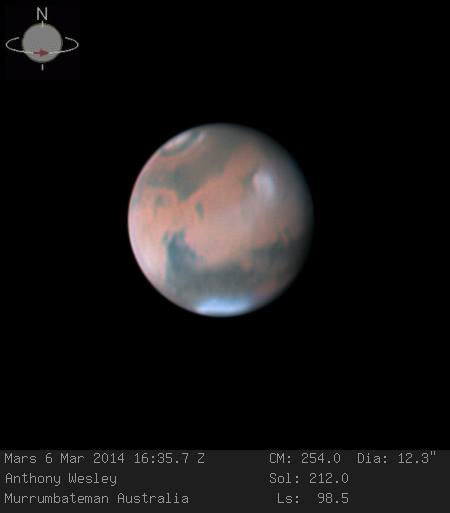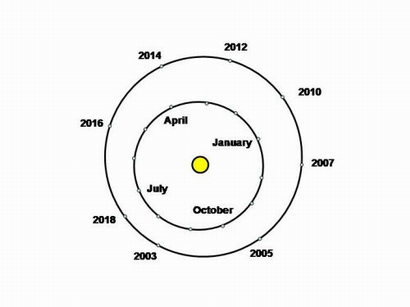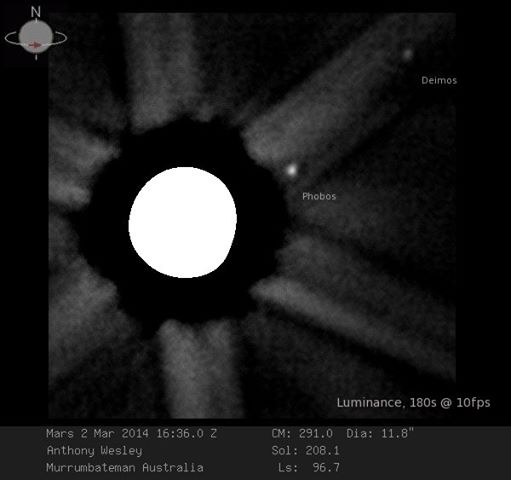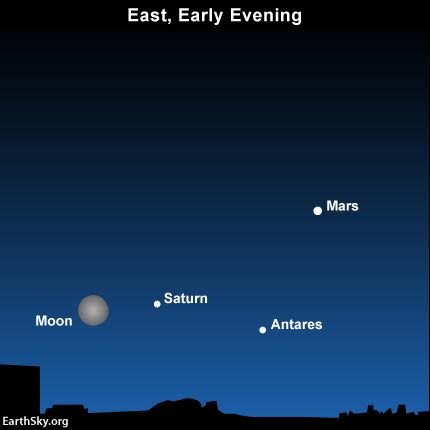Tonight – May 22, 2016 – Mars comes to opposition in our sky for the first time in over two years. It’s the brightest that Mars has appeared in our sky, though, in over 10 years! Mars is now very nearly the same brightness as Jupiter, which has been the brightest starlike up each evening for some weeks. You can’t miss it! Even the drenching moonlight of the waning gibbous moon, just past full on this date and near Mars in the sky, won’t be able to wash the Red Planet from the nighttime sky.
Mars now resides opposite the sun in Earth’s sky, because on this date we are passing between it and the sun in our smaller, faster orbit.
Now opposite the sun, Mars rises in the east around sunset, climbs to its highest point in the sky at midnight, and sets in the west around sunrise.
Mars alternates between good and bad years for viewing in our sky, and 2016 counts as a very good year because it is an opposition year. In the alternate years, Mars stays on the far side of the sun from Earth and is relatively faint and inconspicuous in our sky.


Oppositions of Mars are not created equal, though, and, in 2016, Mars is closer to Earth than in over 10 years, or since the opposition of November 7, 2005.
Super-close oppositions of Mars recur in periods of 15 to 17 years. The last super-close Martian opposition happened on August 28, 2003, and the next one will occur on July 27, 2018. Extra-close oppositions happen when we go between Mars and the sun around the time Mars is closest to the sun. Makes sense, right?
This year’s opposition doesn’t bring Mars as close as it can be. But it’s a good opposition, and Mars is very bright in our sky.
An extra-far opposition took place on March 3, 2012, when Mars was farthest from the sun. Extra-far oppositions also recur in periods of 15 to 17 years. As a basis of comparison, the 2016 opposition of Mars finds the planet nearly 16 million miles (25.5 million km) closer than it was during its March 3, 2012 opposition. Meanwhile, the extra-close martian opposition on July 27, 2018, will find Mars over 27 million miles (43 million km) closer than extra-far opposition of March 3, 2012.

At present, Mars ranks as the fifth-brightest celestial object to light up the heavens – after the sun, moon, Venus and Jupiter. However, Venus is now lost in the glare of the sun, so Mars can rightfully claim the mantle of the fourth-brightest heavenly body in the nighttime sky.
This month showcases Mars at its moment of glory. What’s more, you can use brilliant Mars as your guide “star” to the planet Saturn and the star Antares, the brightest star in the constellation Scorpius, for months to come. In fact, Mars and Saturn will be having a conjunction on August 25, 2016, to stage their first conjunction since August 27, 2014. The next one won’t be until April 2, 2018.
By the way, you can distinguish Saturn from Antares by color. Saturn exhibits a golden hue whereas Antares appears reddish. And, of course, a telescope – even a modest backyard telescope – will show you Saturn’s glorious rings. Although both Saturn and Antares shine at 1st-magnitude brightness, neither Saturn nor Antares holds as candle to Mars right now.

By the way, our exact moment of being closest to Mars will come about a week after opposition, on May 30. If Earth and Mars orbited the sun in perfect circles and on the same exact plane, Earth would come closest to Mars right at opposition. However, Mars always come closest at the vicinity of opposition. The time interval between opposition and Mars’ nearest point to Earth is no greater than 8.5 days, and can be as little as 10 minutes.

Bottom line: May 2016 is the best time in over 10 years to see Mars. Earth passes between Mars and the sun on May 22, 2016 (the martian opposition). Earth and Mars will be closest on May 30, 2016.
Read more: Why is Mars sometimes bright and sometimes faint?












